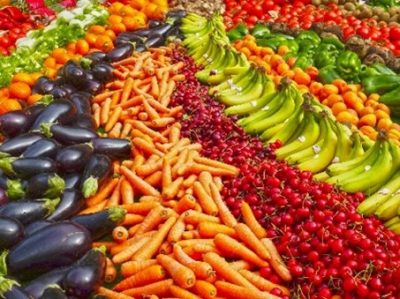Written by UConn Dietetics Masters student Sam Nunes
Have bright and vibrant colored foods ever caught the attention of your eye or your stomach? Our visual experience of food impacts the choices we make when it comes to what we eat. There is a reason for this. There are nutritional benefits and appeal to colorful fruits and vegetables.
stomach? Our visual experience of food impacts the choices we make when it comes to what we eat. There is a reason for this. There are nutritional benefits and appeal to colorful fruits and vegetables.
Green foods are filled with numerous vitamins and minerals that are beneficial to our health. The darker the green the more nutritious. Spinach, for example, has iron, which helps our blood absorb oxygen and supports our immunity.
Orange foods such as carrots and sweet potatoes are colored by carotenoids, which change into Vitamin A in our bodies. Vitamin A is very important for eye and skin health.
Blue and purple are colors found in our foods, too! In particular, blueberries have flavonoids in their skin which give them their blue color. Flavonoids protect our cell membranes from damage. They are also anti-inflammatory which is important to keep our bodies healthy and free from chronic disease.
The colors in food provide more than just a pleasing image to look at when we eat. As humans, over time, we have come to recognize and select foods that are more colorful. For example, the ripe red tomato is more appealing than the unripe green one.
When you are making your meals, try to get as much color as possible. Not only does this give you a beautiful plate to enjoy looking at before eating, but it also ensures that you are getting a meal packed with nutrients that will benefit your body and health. You’ve heard the saying, “eat your greens,” but don’t forget to eat your reds, oranges, yellows, blues, and purples as well!
Smoothie Recipe (An easy way to eat lots of colors together!)
- Pick a variety of fruits of different colors: (Pick a few)
- Red – Strawberries, Cherries, Raspberries
- Orange – Cantaloupe, Mango
- Yellow – Banana, Pineapple
- Blue – Blueberries
- Purple – Grapes, Plum
- Add in some vegetables as well for added nutrition!
- Kale
- Spinach
- Carrots
- Mix with about a ¼ cup of Greek yogurt for added calcium and protein!
- Add in a ½ cup of milk or milk alternative (for ex: almond milk) to add in some nutritious fluids!
Mix together in a blender and enjoy! Have some fun with it! Try different combos to find your favorite.
Sources:
https://foodinsight.org/eat-a-rainbow-functional-foods-and-their-colorful-components/
https://pubmed.ncbi.nlm.nih.gov/28620474/
This material is funded by UDSA’s Supplemental Nutrition Assistance Program (SNAP).
This institution is an equal opportunity provider.